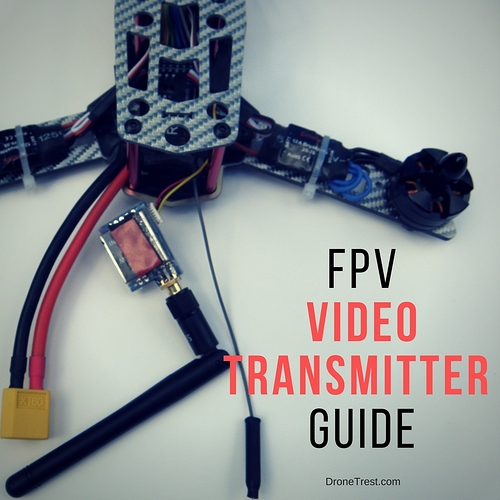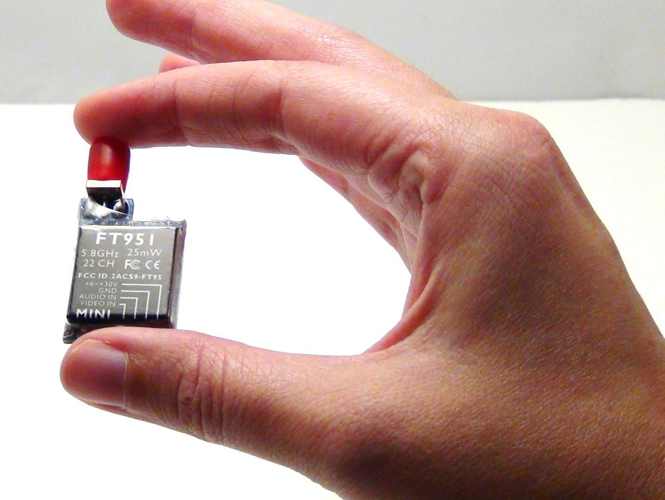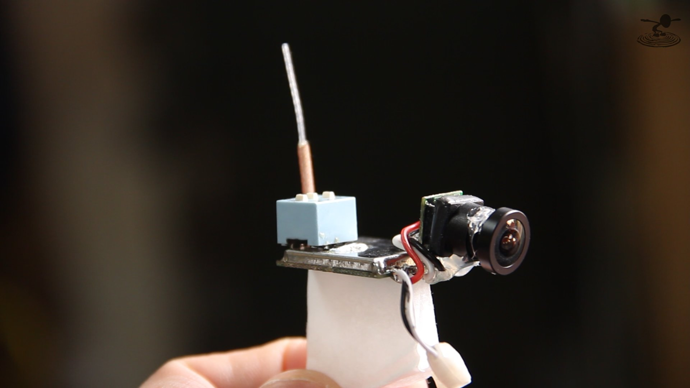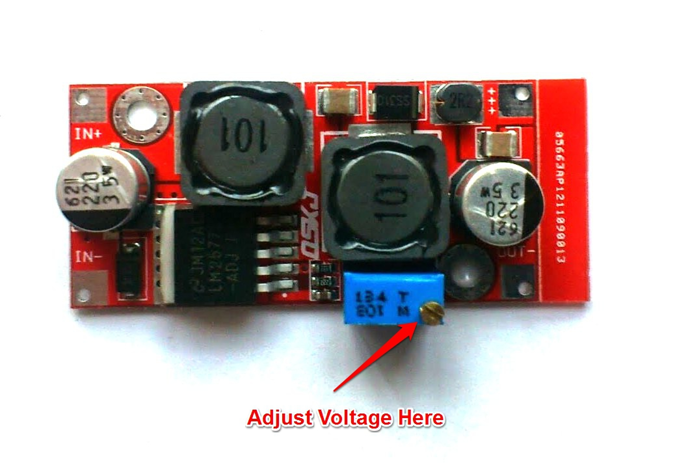A video transmitter (VTX) is a device that is connected to your camera and transmits the video signal from your drone back down to you on the ground over the airwaves in real time. There are literally hundreds of video transmitters available on the market today each with its frequency, power levels and antennas. In this guide I will tell you the main factors you need to know about when it comes to choosing the best FPV video Transmitter (TX) for your drone.
What Frequency
The frequency your FPV transmitter runs on is the most important thing to consider. Nowadays most FPV equipment runs on 5.8Ghz since its legal to use for FPV use in most parts of the world. Depending where you are located you can also use 900Mhz (popular in USA), 1.3Ghz, or 2.4Ghz to transmit your FPV video signal on.
Why is 5.8Ghz the best frequency?
5.8Ghz is by far the most popular frequency used for FPV, but it is not technically the best. Higher frequency signals can carry more bandwidth (which is good) but have a much harder time penetrating obstacles such as walls/ trees (which is bad). So if you use a lower frequency transmitter such as 900Mhz you will most likey have a more reliable signal since it can pass through objects easier, but since 900Mhz is not open for use in the UK, and most of Europe we cant use this for video  . Also 5.8GHz antennas are much smaller which makes using 5.8Ghz transmitters easier and cheaper. With the correct setup you can easily fly very far with a standard (and fully legal) 5.8Ghz FPV setup, with some pilots reporting 2Km range.
. Also 5.8GHz antennas are much smaller which makes using 5.8Ghz transmitters easier and cheaper. With the correct setup you can easily fly very far with a standard (and fully legal) 5.8Ghz FPV setup, with some pilots reporting 2Km range.
You can also use 2.4Ghz for FPV legally in Europe, however since almost all R/C equipment (and WiFi) runs on 2.4Ghz, you will usually receive lots of interference on this band. Or if you start flying far away your onboard 2.4Ghz FPV transmitter signal could drown out your 2.4Ghz R/C control signal which is sent from the ground, resulting in your drone loosing control  .
.
So you dont really have much choice when it comes to frequency selection for video, which is why most of us use 5.8GHz.
How many Channels
Just like with television, you need to tune your TV  to specific channels, a transmitter can be set to broadcast on a specific frequency or channel. Having more channels you can set on your FPV transmitter is useful if flying with other FPV pilots as each pilot will fly on a different frequency so your FPV video does not interfere with theirs.
to specific channels, a transmitter can be set to broadcast on a specific frequency or channel. Having more channels you can set on your FPV transmitter is useful if flying with other FPV pilots as each pilot will fly on a different frequency so your FPV video does not interfere with theirs.
Today its common to find either 32 channel FPV transmiitters, or 40 channel FPV transmitters. Each transmitter will have a frequency table that shows you the list of channels, and bands and their corresponding frequency. An example of such a table is shown below.

RaceBand
As FPV racing becomes more popular, and more FPV pilots are flying in a single event, its important to have more channels available. So many new FPV transmitters now include the Raceband frequency range, which allows some transmitters/receivers to choose from 40 channels.
Will my FPV equipment work with my FPV transmitter?
Its important to make sure your FPV transmitter is compatible with your FPV reciever, goggles or monitor. Often certain brands will use specific frequency bands to try force you to stick with using their FPV equipment. However the most importnat thing is to check that there are compatible channels between your FPV transmitter and receiver, so that they can both run on exactly the same frequency. However with today’s 40CH transmitters, are literally compatible with all FPV receivers,goggles and monitors.
Power Levels
Its a common misinterpretation that if you double the output power of your transmitter, you will get double the range. Unfortunately this is not the case, the power to range function follows the inverse square rule. So if you double the power, you only get a quarter extra range. If you are looking to get the most range out of your FPV system, its best to focus on using the best possible antennas on your transmitter, and high gain antennas on your FPV receiver.
What power level can I use legally?
There are some regulations as to what frequencies and power levels you can use. Currently in the UK, and most of Europe we are limited to just 25mW of power with our FPV transmitters. Despite this you will find numerous FPV transmitters with much higher power levels for sale, in USA 200mW is quite common. It is possible to use higher power transmitters, but this will often require you obtain permission from OFCOM and you will also need an amateur radio licence.
Although at the time this is accurate to the best of my knowledge, its important that you check the regulations yourself before using any FPV equipment.
Update: THanks to @CF-FZG for pointing this out… [quote=“CF-FZG, post:10, topic:1470”]
“There is a belief that the use of higher power equipment can be authorised by applying for an Amateur Radio licence. This is wrong. Amateur Radio licence expressly prohibits use in any aircraft or airborne vehicle. This restriction is not relaxed for, radio-controlled models, aeroplanes and balloons.”
[/quote]
That said it is not uncommon for drone pilots to use more powerful FPV transmitters here in the UK such as 200mW. Although technically its not allowed if you are in open field away from built up areas you will not cause any extra interference with anything on 5.8GHz so no one will ever notice. To date I am yet to see anyone being prosecuted for using more poewrfull FPV systems. However its always best to stick to the rules and only use 25mW FPV systems.
Power Requirements
When I say power requirements, i am talking about the voltage, and not the video transmission power. When buying a FPV transmitter its a good idea to double check that its supports the voltage of your flight battery. So if your FPV transmitter run on a maximum of 12V, you cant connect it directly to your 4S LiPo battery directly. If your FPV system uses a lower voltage you can always use a voltage regulator to control the voltage supplied to your FPV gear. Other things to consider is using an LC filter to ensure your system has a smooth power supply to ensure the best performance of your FPV gear.
Further Reading
Now that you know the basics of FPV transmitters, its a good idea to check out our FPV antennas guide to make usre you can get the best possible reception out of your FPV transmitter. On the ground you will also need to use an FPV video receiver, monitor or goggles, so check out our FPV receiver guide for more information on that.
Hello,
I am very new to the concept of drones and I have received a drone for a gift. Nothing expensive or fancy just a cheap drone for me to actually give it a go.
I have found a camera made for my drone that is 5.8G and am wondering what comparability I need to check in order to get goggle or a screen that will work. I have found 5.8G screens and goggles but am unsure what to look for as far as comparability is concerned. Any help would be much appreciated.
If you let me know what quadcopter you are using I can let you know what will be compatible. But nowadays most receivers, goggles and monitors have 32CH 5.8Ghz receivers built into them so they are compatible with just about any FPV system.
If only all Suppliers wrote such fantastic guides! Good job unmanned/drone…
Thanks for you kind words, if you ever have any suggestions about what guide I should write please let me know 
I thought this statement was wrong so I had to check.
This topic was mentioned previously several years ago on a model aircraft forum, and according to OFCOM;
“There is a belief that the use of higher power equipment can be authorised by applying for an Amateur Radio licence. This is wrong. Amateur Radio licence expressly prohibits use in any aircraft or airborne vehicle. This restriction is not relaxed for, radio-controlled models, aeroplanes and balloons.”
The full article is here
Penalties if you are caught using a higher powered (over 25mW on 5.8GHz or 10mW on 2.4GHz non-frequency-hopping) airborne transmitter can be quite high.
What’s the maximum resolution FPV that can be transmitted wirelessly? To give this some context, most goggles go up to around 600TVL, but I wish to use my Samsung S7 + Gear VR. The phone screen has a 3.7MP resolution and with an OTG (on the go) adapter cable plus an RCA to USB adapter (EasyCap UTV007), I have been able to receive the 5.8GHz transmission from my friend’s drone.
But before I head out there and buy, I’d like to know the best options that I have. And to be clear, resolution takes higher priority for me, over latency. Any advice is greatly appreciated at this stage.
Most video transmitters used for fpv racong are analogue as they are much cheaper and have low latency. The max resolution for analogue systems is about 700TVL, but you can get some cameras that output 1000TVL although there is a max resolution an analogue video feed can have which is around 700TVL apparently (I’m not an expert here) so using expensive HD TV goggles for fpv is abit pointless as the max resolution is about VGA quality (700x480). I talk more about this in my fpv camera guide:
If you want us video then you need to use a digital video feed, currently the chepest you get is about £500 (Ammon conned). But there are esomewhre cheaper diy versions that involves using two raspberry pi and long range WiFi cards.
Hello, I recently received a makerfire Bibi bird 210 as a gift… It came with everything but a transmitter, and video receiver. However, the website does not specify what frequency my video transmitter transmits. Is there a way to discover this?
Yes you will need to ask the seller, but I am fairly certain it will be 5.8ghz
I don’t know much about this, as I am still quite new, but compare the channels and bands on both the transmitter and receiver, and if you see both numbers, you should be good.
Hi,
I am busy with my second build and I would just like to know what do I need to do to get the most distance between me and my drone and still have live footage? I live on a huge farm in South Africa so lets pretend for a moment that there are no frequency and power limitations to the video TX. I’m building a huge build, 1.250m class octocopter, that I want to use to monitor all the breeding camps with on the farm. For that I need to be able to fly far distances while maintaining live video feedback. I will be mounting a top of the range DSLR camera to the drone since I will also need to take high quality photos of the animals from time to time. What would you recommend?
I suggest you check out the fpv antenna guide as antennas are the most important when it comes to range. Getting a directional high gain antenna with a high power transmitter should work well to give a few Km range ![]()
Hi
If you put the remote control onto UHF and use 2.4Ghz for the video with 800mW and the right antennas you should get 20+ miles
See www.maxmyrange.com
There are other options available, what range do you need for your Farm?
Cheers
Steve ![]()
Yeah i guess something i forgot to mention is that you will almost definitely need to use UHF R/C control as most 2.4Ghz gear only has a range of about 2Km (or 4 in the case of radiolink at10v2)
Thank you Alex and thank you Steve. Sorry for the late reply I had to put my project to a hold for a while. Ok I’ve gone through the transmitter article as well as the antenna article. The antenna article really helped a lot and I think I know which polarization to go with (Linear and high gain directional) to get the best range out of my antenna. What does the video quality look like with a high range antenna? What sort of Transmitter and Receiver combination would I need to get the best quality video (Full HD) at a maximum range of 10Km.



